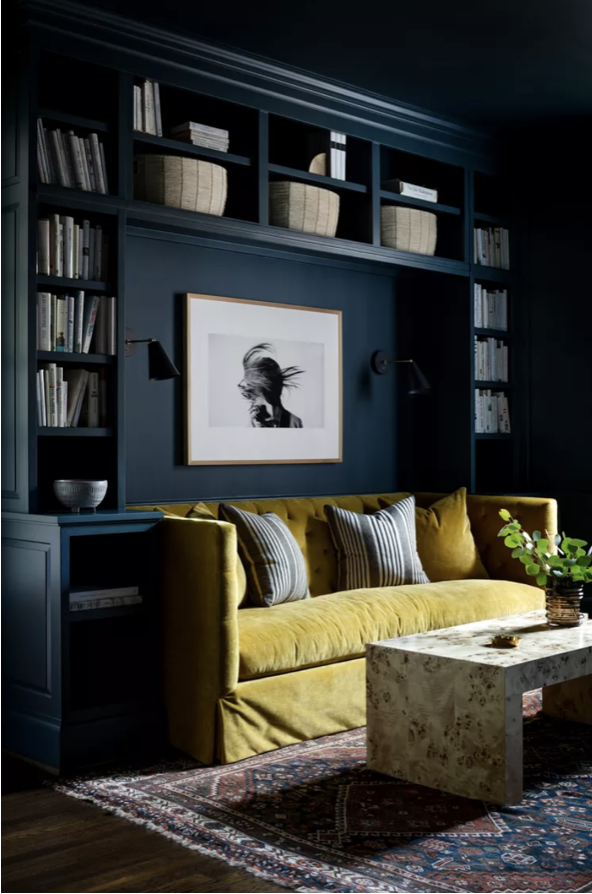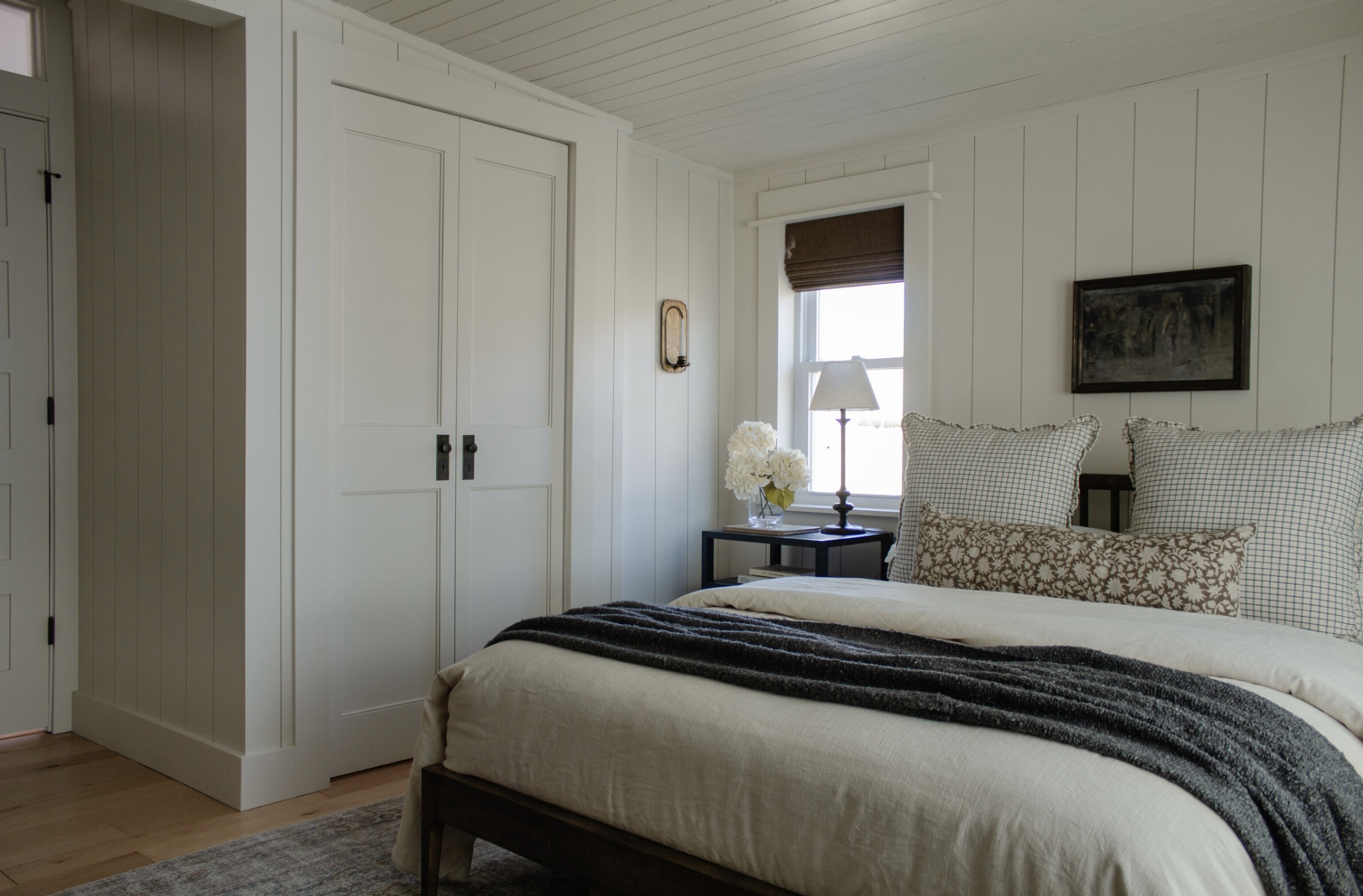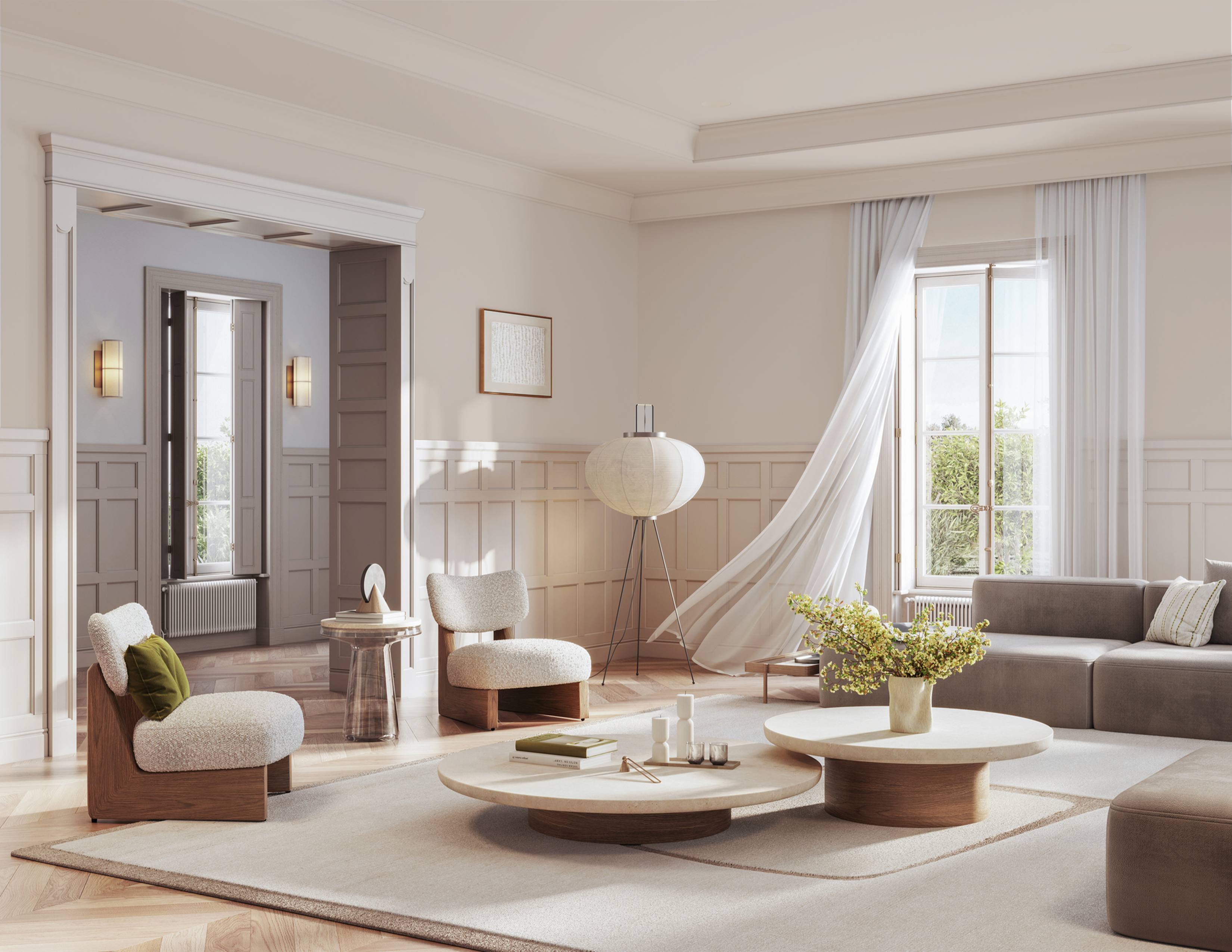Photo Credit - Paul Massey
Colour Drenching vs. Monochromatic Colour Scheme: What’s the Difference?
Both colour drenching and monochromatic schemes have attracted significant attention lately, but while they may appear similar in theory, they bring distinctly different vibes to a space.
Here’s an explanation of how each technique works and how to choose the right one for your interior design style goals.
Colour Drenching Dark Hues: Immersive & Bold
What It Is: Dark colour drenching uses a single colour to cover every surface in a room—walls, ceiling, trim, millwork and doors. This creates an immersive look, making the room feel like it’s “wrapped” in one unified hue. In some cases, even furniture and other features of a room are painted with the same colour.
Where It Works Best: This trend is fantastic for rooms where you want a cocooning, intimate feel, like bedrooms, reading nooks, or powder rooms. It’s especially impactful with colours like forest green, rich plum purples, or deep navy.
The Vibe: Bold, dramatic, and high-impact. Colour drenching transforms rooms into all-encompassing spaces where the chosen colour takes centre stage.

Photo Credit - Jennifer Hughes
Colour Drenching Light Hues: Modern Minimal Look
What It Is: Light colour drenching can have beautiful benefits, bringing a fresh twist to this typically bold trend. Light colour drenching offers a clean, cohesive look without feeling overpowering. By blanketing walls, ceiling, doors, millwork and trim in the same soft hue, you create a seamless, minimalist design that’s understated yet sophisticated.
Where It Works Best: Light colours reflect more natural and artificial light, making the space feel larger and airier. Colour drenching with soft whites, pastels, or gentle neutrals helps create an open, expansive feel, even in smaller rooms.
The Vibe: Overall, light colour drenching is ideal for creating an inviting, peaceful space that feels modern, versatile, and easy to style around. Whether it’s creamy beige, soft lavender, or airy blue, using a light shade lets you enjoy the benefits of colour drenching with a softer, more spacious vibe.
 Photo Credit - Nadine Stay
Photo Credit - Nadine Stay
Where to Use Colour Drenching
Colour drenching works well in spaces of all sizes but is especially impactful in smaller rooms where a sense of unity can make the space feel more spacious. Consider trying this technique in:
- Bedrooms: Deep, relaxing tones create a peaceful retreat.
- Living Rooms: Warm neutrals make the space feel cozy and inviting.
- Bathrooms: Bold colours make small bathrooms feel luxurious and chic.
If you’re ready to try something new, colour drenching is a trend that brings style, depth, and personality to any room. With the right paint colour, this technique can turn a simple space into a design statement, one that wraps you in colour from floor to ceiling. Dive into your favourite hue and let colour drenching transform your home into an immersive experience.
How to Apply Colour Drenching in Your Home
- Plan Your Surfaces: Decide which surfaces to paint. Walls, ceilings, trim, millwork and even doors can be included for a full effect. Keep in mind that this full effect of colour drenching occurs when everything receives the same colour of paint.
- Use the Right Finish: For a unified look, choose the same finish for all surfaces (e.g., flat, eggshell or satin). To elevate the look, you can experiment with different finishes on details like trim. For example, ceiling in flat, walls in eggshell and trim in satin. The subtle nuance of the sheen change slightly alters the way we interpret the colour and that creates visual interest, especially with dark colours. The light hits each sheen differently, each surface looks different despite being the same hue.
- Balance with Decor: The right decor items enhance the feel of the space. Add decor pieces in contrasting or neutral tones. Soft furnishings, rugs, and artwork can break up the intensity while enhancing the space's overall feel. Balance the look by choosing rugs with pattern that implies a similar colour to the main drench colour. Be sure to add textural items (textile art, pillows, baskets, throws etc.) to create depth.
Monochromatic Colour Scheme: Layered & Harmonious
What It Is: A monochromatic colour scheme involves using various shades, tints, or tones of the same colour family throughout a room. For example, a room in soft taupe could include light taupe walls, medium-taupe furniture, and deep mocha decor. This adds depth and dimension while keeping a cohesive look.
Where It Works Best: Monochromatic schemes suit a variety of spaces, from living rooms to kitchens, as they’re versatile and provide a balanced, layered look without overwhelming the eye.
The Vibe: Subtle, harmonious, and sophisticated. Monochromatic schemes add interest through tone and shade variation, creating a calm, well-coordinated aesthetic.
Key Differences
- Colour Drenching focuses on a single colour value for all surfaces, creating a unified look.
- Monochromatic Schemes use a range of tones and shades within the same colour family, providing depth through gradual variations and tonal layering.
How to Apply a Monochromatic Colour Scheme in your Home
- Plan Your Surfaces: Choose a base colour for your walls. Since the walls will likely be your largest area, plan on a light colour to be your starting point. You can carry this colour onto your ceiling or choose an even lighter version of your wall colour for added ceiling dimension. For your trims and millwork, choose the same colour as your walls except two shades darker. If you only choose one shade darker, you run the risk of not being able to tell the difference between the two areas. However, it all depends on how subtle you wish the vibe to be.
- Use the Right Finish: As with the colour drench aesthetic, consider changing the sheen level between walls and trim. A flat sheen on the walls and a satin on the trims and millwork will continue to add subtle depth to the overall monochromatic vibe.
- Balance with Decor: Carry a paint swatch sample of both your trim and wall colour to shop for textiles and accessories in various shades of the same colour, paying special attention to the undertones as you go along. Remember that contrast creates visual interest and so does texture so think of soft furnishings, thick wool rugs and woven baskets in your accessorizing.

Which One to Choose? Drenched or Monochromatic?
Both approaches have unique appeal and can be tailored to suit different design objectives. Whether aiming for a bold, immersive environment or a nuanced, layered aesthetic, understanding the distinctions between colour drenching and monochromatic schemes enables more informed and effective design choices.